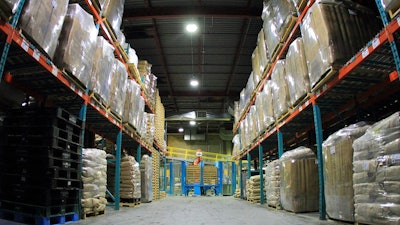
When considering an upgrade to modern, industrial LED lighting, most companies focus on the long life, low-maintenance and energy-efficient operation of these solid-state fixtures and rightfully so. High-quality, well-designed industrial LED lighting has proven to last 10 years or more, virtually eliminating lighting maintenance while also drastically reducing lighting energy consumption by as much as 80%, both of which can add up to huge bottom-line savings.
But, in addition to these compelling money-saving benefits, industrial LED lighting can also substantially improve facility safety. This is especially critical in the food manufacturing industry, which ranks as one of the most dangerous workplace environments. In fact, according to the Bureau of Labor Statistics, food manufacturing workers are more likely to suffer fatal and nonfatal injuries than those in all of the private industry.
With as many as 93,000 injuries and illnesses in a single year alone, that equates to 6.2 cases per 100 workers, compared to just 5 cases per 100 in general manufacturing. This high rate of risk is 59% higher than the overall rate for private industry at just 3.9 cases per 100 employees. Worse yet, 50 workers were killed on the job each year between 2011-2015.
These incidents take a tremendous toll on the workers and their families, as well as costing companies’ significant money when it comes to payments for accident and injury claims, production loses and lost time. According to a study by the Industrial Commission of Ohio, the food and beverage industry “ranks last and worst, respectively, in the incidence of lost workdays” with 3 out of every 8 occupational illness cases involving lost workdays.
With all of this risk, food manufacturers have an obligation to do everything they can to improve workplace safety and prevent these tragic incidents that can not only ruin workers’ lives, but also have a direct and negative impact on company performance, the ability to hire staff and profitability.
LED lighting has shown tremendous potential to help mitigate some of the biggest risks in food production and to provide a safer environment for workers. Here are five ways investing in industrial-grade LED lighting can improve food manufacturing safety.
 Dialight
Dialight
LED lighting provides bright, crisp, clear lighting that eliminates harsh shadows and delivers more uniform light than conventional light sources like HID. This ensures better visibility and has even shown to help keep workers more alert—a key safety issue particularly when staff work afternoon and overnight shifts.
2) LED lighting provides better color clarity. HID lighting such as metal halides commonly used in industrial settings produce an unnatural orange-hued light that makes it extremely difficult to distinguish colors. With a color rending index (CRI) of as low as 65, these lights make it difficult for workers to correctly identifying the color of liquids (is it water, an oil or additive?) that could lead to slip and fall accidents. They can also have a hard time interpreting color-coded indicators and warning signs, for example on additive labels, lockout/tagout cards and more, which could lead to serious production issues or injuries.
With a CRI of at least 80 or 90, LED lighting closely mimics natural daylight, which provides unmistakable color clarity. Colors appear true, allowing workers to easily distinguish them and understand their meaning to help make safer decisions that reduce accidents and injuries on the job.
3) LEDs offer better light distribution and uniformity. Especially now, as COVID-19 mitigation guidelines require food manufacturers to safely space workers along the production line, inadequate lighting is becoming an issue. Most conventional sources lack the ability to strategically place the light. That means when workers move outside of their normal area, inadequate lighting forces many companies to use temporary, supplemental lighting. This not only costs more and is inefficient, but also exposes workers to new tripping hazards from light stands and extension cords where there were previously none.
In contrast, LED lighting allows for precision light placement that ensures ample, uniform light exactly where it’s needed most. With LED fixtures, strategic placement of the LEDs themselves work in tandem with optic reflectors to create precise lighting schematics, which means workers can see clearly and don’t have to rely on supplemental lighting. This allows safe distancing of workers to prevent infectious disease spread without the added risk of tripping hazards.
4) LED lighting offers superior fire and explosion resistance. Airborne particles present a serious risk of ignition, particularly in grain handling and sugar processing facilities, as well as any environment where powdered ingredients and additives are used. In fact, nearly a fourth of fatalities in food processing are the result of fire or explosion, with sugar and confectionary products responsible for the highest number of fatal injuries, such as the Imperial Sugar incident that left 14 dead and 36 injured, along with a Royal, Iowa grain elevator explosion that forced the evacuation of nearby homes.
The use of industrial-grade hazardous location certified LED lighting is a must in these environments, substantially reducing the risk of spontaneous ignition of airborne and accumulated particles. Because LEDs run cooler than conventional lighting, they’re extremely tolerant of ambient heat, which means they won’t explode or ignite particles or catch fire from material accumulation. By the nature of their design as sealed fixtures, LED luminaries that are UL 844 certified also prevent ingress of particles. And, unlike conventional fixtures that are prone to catastrophic explosion upon failure, LEDs will not, which is a critical safety differentiator.
5) LED fixtures offer exceptional corrosion resistance. Ammonia is commonly used as a coolant in food processing, but it is also extremely dangerous. In addition to thousands of direct exposure injuries workers suffer each year, ammonia is also extremely hard on lighting equipment. Not only is it highly corrosive, which can cause premature failure of conventional fixture components, but it’s also highly flammable and explosive. That means if a fixture becomes compromised, ammonia vapors could easily penetrate the housing, creating a substantial risk for a catastrophic event.
Industrial-grade LEDs, on the other hand, offer superior corrosion resistance even in the harshest environments. Proven to withstand years of abuse from seawater spray and petroleum-based materials, high-quality LED fixtures are designed to withstand these assaults, lasting far longer than conventional fixtures. And for added safety, hazardous location certified models carry virtually zero risk of fire or explosion in the event of fixture failure.
For a multitude of reasons, any safety upgrade is a wise investment for any facility. And, while many companies don’t consider lighting to be central to their safety strategy, how you choose to light a work area can play a major role in mitigating the risk of accidents and protecting workers from injury—or worse.
While there’s never a bad time to invest in safety, now is a particularly good opportunity to invest in upgraded lighting for food and beverage facilities. COVID regulations have reduced the number of staff on the floor, which means you may be able to upgrade with fewer disruptions to the production lines below. And in certain cases, the project may even qualify for some CARES Act tax benefits to implement COVID-related upgrades, such as enhanced lighting to accommodate  Ramirez
Ramirez
Regardless of when you make the switch, upgrading to industrial LED lighting offers numerous critical safety benefits for food manufacturing and processing facilities. In an industry with the highest risk of accidents, injuries and fatalities, the real question is: can you afford not to?
Luis Ramirez is the Chief Operations Officer at Dialight.























